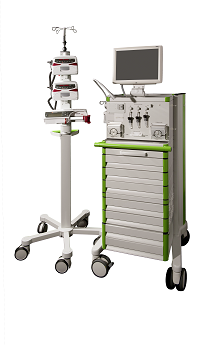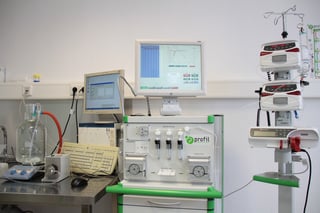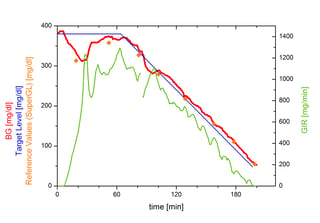Glucose Clamps
The euglycemic, hyperinsulinemic glucose clamp is the gold standard for the determination of pharmacokinetic and pharmacodynamic (PK/PD) effects of (new) anti-diabetic drugs, in particular insulins. In a typical glucose clamp experiment, a drug-induced decline in blood glucose (BG) concentrations is prevented by infusing glucose with a variable glucose infusion rates (GIR) to keep blood glucose concentrations (BG) as closely as possible to a pre-defined target level.
Thus, the glucose clamp is designed as a closed-loop system where BG is measured frequently and the changes in BG and deviation of BG from the target level are the major factors for determining glucose infusion rates.
Glucose clamps (watch our free online seminar on glucose clamps) can be done either manually or in an automated fashion. In manual clamps the investigator performs BG measurements and manually adjusts GIR every 3–10 minutes, whereas in automated clamps, BG is measured continuously and GIR is adapted every minute by an implemented algorithm. For a long time, the performance of automated glucose clamps has been hampered by the outdated technology of the Biostator, a clamp device developed in the early 1970ies. More modern devices such as ClampArt® should not only improve the quality of continuous BG-measurements and the accuracy of glucose delivery, but might also offer new options for the design of glucose clamps.
One of these options could be to use a changing rather than a fixed target BG level in a glucose clamp. This might be particularly interesting for the assessment of glucose-stimulated insulin secretion capacity which has been done by "graded glucose infusions" or to determine the accuracy and technical lag times of continuous glucose monitoring systems (CGMS). However, establishing precise rate-of-BG-changes (RoC) with graded glucose infusions is technically challenging.
ClampArt:

The option to use a pre-defined changing BG target in a glucose clamps was implemented in the control software of the ClampArt® device, a proprietary development of Profil, Neuss, Germany for automated glucose clamps which is CE-marked and licensed for use in Europe. ClampArt® uses a fully validated state-of-the-art technology to perform BG measurements and GIR-adaptations every minute. The device shows good accuracy in BG measurement und reliable GIR calculations by using an optimized Biostator algorithm. ClampArt® needs only one calibration at the very beginning of the experiment.
For the option of using a pre-defined changing BG target software of ClampArt® was refined and the option of clamps with precise RoC-settings by adding a constant pre-defined target-step each minute was implemented. For positive changes in the target level the p-RoC option (TLt = TLt-1 + x) was used whereas for negative slopes the n-RoC option (TLt = TLt-1 – x) was selected (RoC = rate of BG changes, TL = Target Level, x = 0.5 mg/dl, 1.5 mg/dl, 2.5 mg/dl, 3.5 mg/dl).
The refined software of ClampArt® therefore allows to pre-define a specific target level as well as the rate-of-BG-change from that level over a given time period.
Methods:
The new software features of ClampArt® device allowing precise RoC-clamps were tested in in-vitro experiments as described below. A 5 l container filled with glucose solution at different concentrations was used as "volunteer".

For positive glucose slopes, ClampArt® infused glucose solution into the container to raise glucose concentrations from 50 mg/dl by 0.5, 1.5, 2.5 and 3.5 mg/dl per minute to about 400 mg/dl.
For negative BG slopes the effect of short-acting insulin was needed as the ClampArt® device only uses glucose solution for regulation. The insulin effect was mimicked through a suitable variable water infusion into the container (dilution of the glucose concentration). If needed, ClampArt® infused glucose at a variable rate to prevent a faster than desired rate of glucose decline. The glucose concentrations were cross-checked by a reference glucose measurement method (Super GL).
The refined Biostator algorithm was used by ClampArt® to calculate and administer the appropriate amount of glucose solution to keep the glucose concentration at both the fixed target level (at the start of the experiment) and the rising/falling target level (after activation of the RoC mode) as close as possible.
Results:
The figures below show examples of a RoC-clamp with an increasing target level (TLt = TLt-1 + 1.5 mg/dl/min, top) and a RoC-clamp with a declining target level (TLt = TLt-1 - 2.5 mg/dl/min, bottom).

In the first 70 minutes, the target level was fixed at 50 mg/dl and 380 mg/dl, respectively, using the software mode for common automated glucose clamps. After 70 minutes, the software was switched to RoC-mode and the target levels as well as the actual glucose concentrations started rising or declining.
The in-vitro experiments started and ended with unphysiologically low and high glucose concentrations to show that the rise and the decline of the glucose values can be obtained throughout the entire glucose range.
 All experiments performed show precise rate-of-BG-changes with both increasing and declining BG targets.
All experiments performed show precise rate-of-BG-changes with both increasing and declining BG targets.
All experiments were performed twice with different rate of changes of 0.5, 1.5, 2.5 and 3.5 mg/dl per minute for positive slopes and -0.5, -1.5, -2.5 and -3.5 mg/dl per minute for negative slopes.
No substantial differences were observed between the different change rates.
|
positive slope |
negative slope |
|
|
Number of data points |
2586 |
2934 |
|
Total RoC-time |
43 h |
49 h |
|
Deviation from target* |
0.3±1.0 mg/dl |
6.2±4.5 mg/dl |
|
Time deviation** |
-1.1±2.3 min |
4.9±3.2 min |
|
* Mean (BG-TL) ± Standard deviation ** Time difference between measured time to reach final target concentrations and the calculated time periods (TLfinal – TLstart) / RoC. |
||
The values shown above for ‘deviation from target level’ as well as the ‘time to reach final target level’ are better for positive than for negative slopes. This is due to the fact, that no additional short acting insulin is needed for positive slopes in contrast to negative slopes. As the device itself can only raise BG by infusing 20% glucose solution, a short acting insulin is needed to induce negative slopes which, however, slightly increases the complexity of the regulation.
Conclusions:
The new RoC-software of ClampArt® establishes precise and automatically controlled BG change rates for rising and declining BG values.
This allows e.g. the investigation of the accuracy of CGMS at different rates of BG changes or the assessment of glucose-stimulated insulin secretion with a high degree of standardization and at high clamp quality.
Planned next steps are the verification of the results shown in clinical studies and the selection of the optimal short-acting insulin for declining RoC-clamps.




